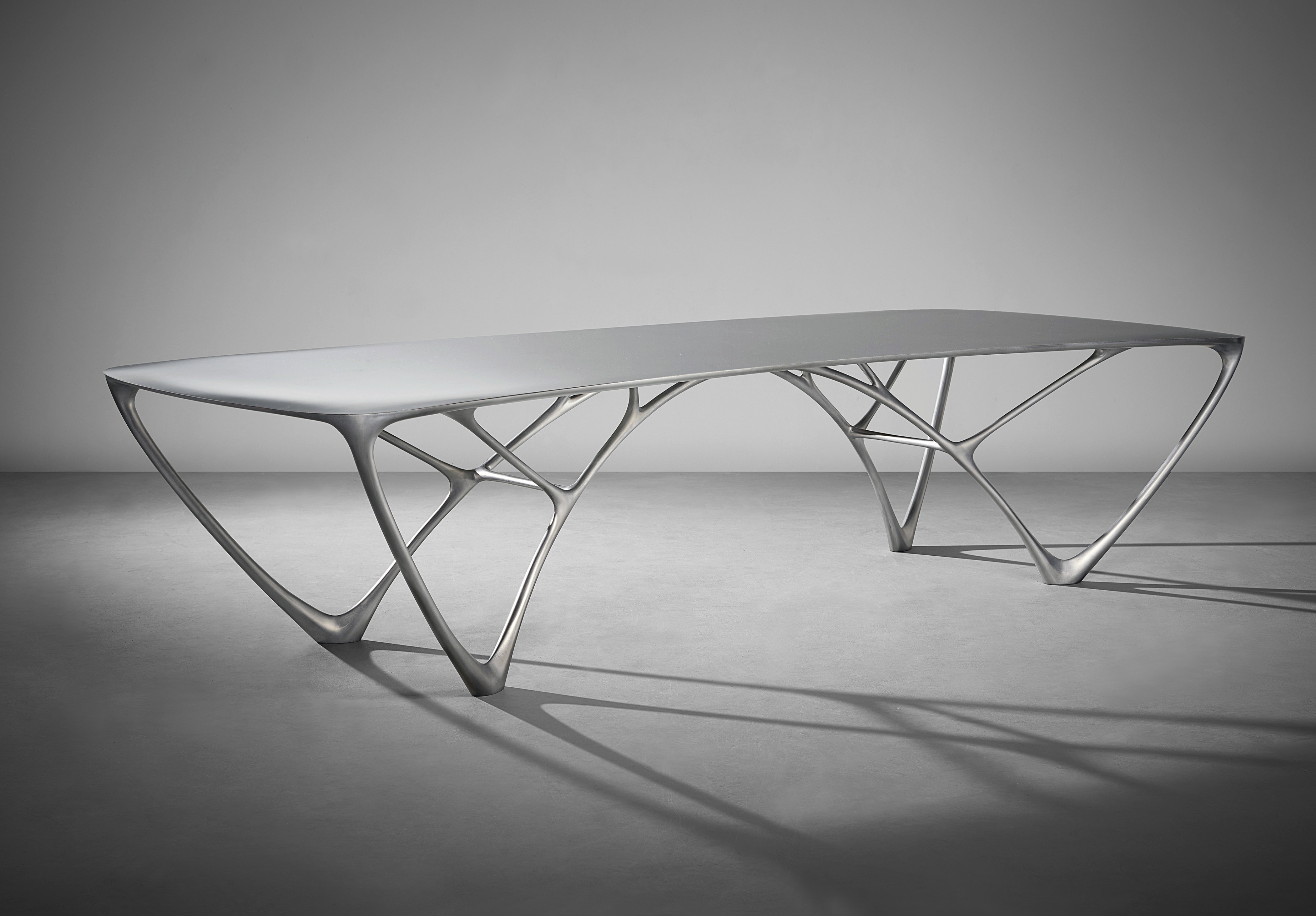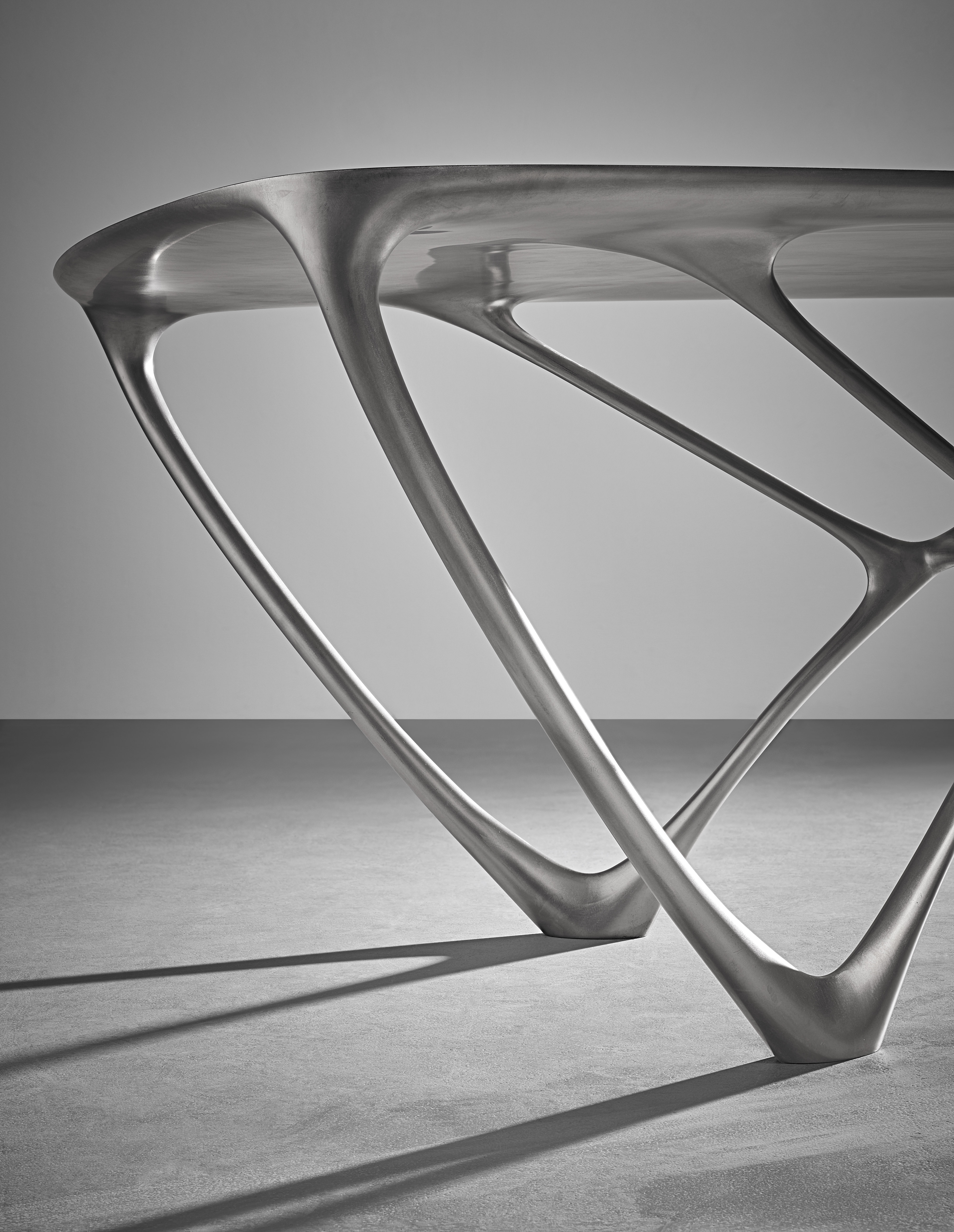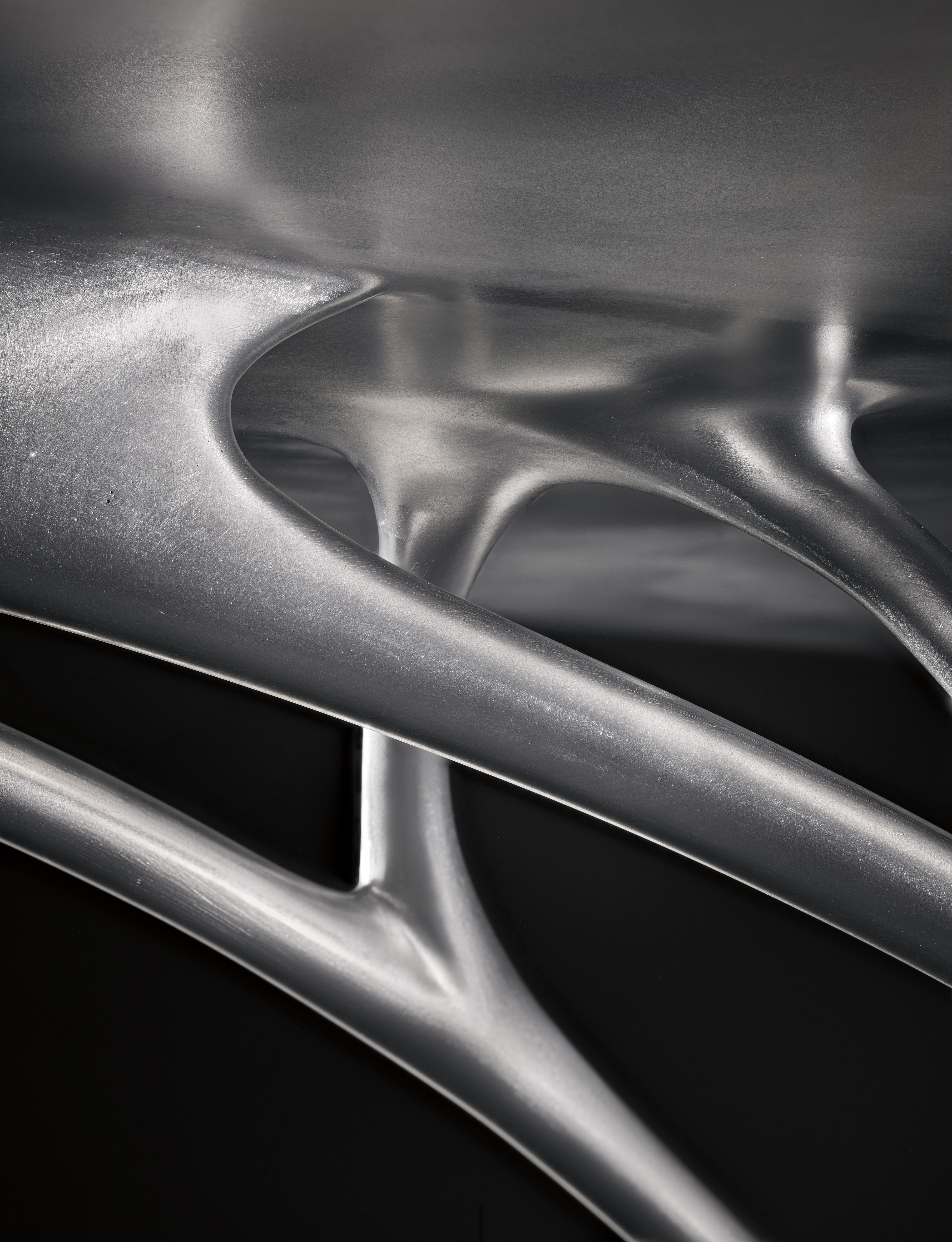







Property from an important Swiss collection
221
Joris Laarman
Important 'Bridge' table
2010
Aluminium, tungsten carbide.
74.5 x 330 x 127 cm (29 3/8 x 129 7/8 x 50 in.)
Produced by Joris Laarman Studio, the Netherlands, for Barry Friedman Gallery, New York. Number 7 from the edition of 8. Underside laser-etched with facsimile signature Joris Laarman and 7/8.
Full-Cataloguing
Another example of the Bridge table is in the permanent collection of the National Gallery of Victoria, Melbourne, Australia.
Phillips and Dr. Jana Scholze would like to thank Joris Laarman for this interview.
The Bridge table by Joris Laarman
by Jana Scholze
Boundaries between disciplines are ever more blurred and distinctions less obvious. Where does design practice stop and engineering start? Does science influence design, or design inform science? Is technology even possible without design? Such questions become increasingly difficult to answer.
In response, Joris Laarman has implemented an interdisciplinary structure in his studio combining technology and craft. Code-writers, often with an architectural background work together with craftsmen. ‘The studio is like a mini-society where software engineers work together with traditional craftsmen’, Laarman explains, ‘I am very careful with choosing people but most of them come from the same European universities or local craft schools. This is little surprising given that the studio practice needs very specific skills and knowledge, and these schools seem to cherish and most importantly teach them.’ Unsurprisingly, the work of the studio prescribes high-tech and is not shy to use heavy machines and robots. But the final objects demonstrate the fineness of the crafted and hand-finished.
Bridge table is an excellent example of this fusion. It is a monocoque object made in aluminium and tungsten carbide created by algorithms, robots and craftsmen. Its shiny table top continues fluently into an organic structure that supports the table from four points on the ground forming an arch in the middle. The organic appearance is increased through bracing rods that stabilise the arch. The reference is unmistakably bone structures which were Laarman’s inspiration for a whole collection of furniture.
The so-called ‘Bone Furniture’ is based on research, which intends to mimic natural growth structures in bones through smart algorithms. This research had been prompted by observations that bones optimise their growth as an evolutionary process by adding material only were necessary and reducing material where possible. Laarman applied the algorithm in the process of designing furniture, intending to proof the optimal use of material while structural strength was not compromised. The outcome is Laarman’s Bone Furniture, a series of limited edition objects that includes Bone Chair, Bone Chaise, Bone Arm Chair, Bone Rocker, Bridge (table) and Branch (shelf).
After a two year design process, the first object was presented in 2006; it took however more than a decade to materialise a full series, indicating a demanding and ambitious project. The long process also alludes to the fact that the aspiration behind the series was not the completion of a set of furniture but – in the true sense of a laboratory - testing out and facing challenges occurred in the application of such algorithm to objects with different functions in various materials. Laarman emphasises: ‘I am not just interested in furniture but the process offered a valuable field for testing the application. The Bone Furniture is a series of objects that first and foremost represent a world of thinking.’ Now, a decade later, such design algorithms are being implemented in a wide range of industries with the intention to optimise construction and weight.
Despite being a rather large sculptural object, the Bridge table presented its challenge not necessarily in the design of its form and structure, but in its finish.
The choice fell on aluminium because of its material’s qualities, such as being easily malleable, lightweight and low in density, the latter enabling resistance to corrosion; most importantly it allows tension over long spans suiting the suggested over three-meter length. However, the soft material is prone to scratch marks, which is problematic for a surface that - in daily use - is intended to not only have objects placed on it but to be moved around. This functional aspect prompted the search for a durable coating.
Typical for Joris Laarman’s practice, it was the fascination with a technique, High Velocity Oxygen Fuel (HVOF) spray coating that guided the material search. With this technique ultra-dense coatings can be applied to soft materials. Laarman chose tungsten carbide, which is one of the hardest materials on earth, a metal with ceramic-like qualities. It can be polished but only with abrasives of superior rigidity such as diamond. But nobody seemed to have done a large mirror-polished flat surface in the size of the Bridge table. Laarman remembers: ‘We had to find a procedure ourselves and it took us two exhausting months of basically polishing day and night; and our ever closer deadline heightened the pressure. It was unbelievable when after weeks of a seemingly unchanged surface a dark polish appeared. We realised that endurance is the recipe.’ The insight that this polish mainly needs an investment in time as well as very intense labour lead to the development of a tool which is a robotic arm for polishing using high pressure.
The editions of the two different sized Bridge tables have all been realised, sold and are in use. It transpires that the table often becomes a desk rather than a dinner table (as confirmed in a recent tweet by Simon de Pury who saw the Bridge as fashion designer Reed Krakoff’s desk). This application seems sensible as it allows the table to be presented in full view rather than being compromised by surrounding chairs.
The contrast between the matted construction of the table carrying a large surface that disappears through its dark polish emphasises its sculptural qualities. Common design practice would see aspects of the design process such as polishing outsourced. Making it instead inherent to the design process is a distinguishing characteristic of Laarman Lab where the development of tools and techniques an instrumental part of the practice. ‘It is not just the idea but the materialisation of an idea that is key. It is test and testament that an idea holds its ground.’
Laarman’s fascination with technology doesn’t simply lead to a celebration of the new and possible, but aims at finding forms and aesthetics with a fundamental combination of coding and crafting, of studio and workshop practice. Most of his projects rely on collaborations which can be tech companies, scientific or academic institutions. But these partners change with most projects as Laarman is far too curious to commit himself to just one specific area or issue. Equally, he has little interest in developing his designs into mass-manufactured products. Often, his designs prove too challenging for the current state of industrial technology. ‘A huge amount of people are already working on smart industrial products but I prefer to focus on the far distant future and experiment with emerging digitalisation to understand how it is shifting our notion of design and aesthetics in all its facets.’ Laarman specifies, ‘If Ikea or anyone else wants to pick up the challenge of mass producing my work, it would be a great compliment, but I believe that will only happen once digital fabrication is fully implemented.’ It is unpredictable what will catch Laarman’s attention next.
Dr. Jana Scholze, February 2017
Associate Professor, Curating Contemporary Design
School of Art, Design and Architecture
Kingston University, London
Phillips and Dr. Jana Scholze would like to thank Joris Laarman for this interview.
The Bridge table by Joris Laarman
by Jana Scholze
Boundaries between disciplines are ever more blurred and distinctions less obvious. Where does design practice stop and engineering start? Does science influence design, or design inform science? Is technology even possible without design? Such questions become increasingly difficult to answer.
In response, Joris Laarman has implemented an interdisciplinary structure in his studio combining technology and craft. Code-writers, often with an architectural background work together with craftsmen. ‘The studio is like a mini-society where software engineers work together with traditional craftsmen’, Laarman explains, ‘I am very careful with choosing people but most of them come from the same European universities or local craft schools. This is little surprising given that the studio practice needs very specific skills and knowledge, and these schools seem to cherish and most importantly teach them.’ Unsurprisingly, the work of the studio prescribes high-tech and is not shy to use heavy machines and robots. But the final objects demonstrate the fineness of the crafted and hand-finished.
Bridge table is an excellent example of this fusion. It is a monocoque object made in aluminium and tungsten carbide created by algorithms, robots and craftsmen. Its shiny table top continues fluently into an organic structure that supports the table from four points on the ground forming an arch in the middle. The organic appearance is increased through bracing rods that stabilise the arch. The reference is unmistakably bone structures which were Laarman’s inspiration for a whole collection of furniture.
The so-called ‘Bone Furniture’ is based on research, which intends to mimic natural growth structures in bones through smart algorithms. This research had been prompted by observations that bones optimise their growth as an evolutionary process by adding material only were necessary and reducing material where possible. Laarman applied the algorithm in the process of designing furniture, intending to proof the optimal use of material while structural strength was not compromised. The outcome is Laarman’s Bone Furniture, a series of limited edition objects that includes Bone Chair, Bone Chaise, Bone Arm Chair, Bone Rocker, Bridge (table) and Branch (shelf).
After a two year design process, the first object was presented in 2006; it took however more than a decade to materialise a full series, indicating a demanding and ambitious project. The long process also alludes to the fact that the aspiration behind the series was not the completion of a set of furniture but – in the true sense of a laboratory - testing out and facing challenges occurred in the application of such algorithm to objects with different functions in various materials. Laarman emphasises: ‘I am not just interested in furniture but the process offered a valuable field for testing the application. The Bone Furniture is a series of objects that first and foremost represent a world of thinking.’ Now, a decade later, such design algorithms are being implemented in a wide range of industries with the intention to optimise construction and weight.
Despite being a rather large sculptural object, the Bridge table presented its challenge not necessarily in the design of its form and structure, but in its finish.
The choice fell on aluminium because of its material’s qualities, such as being easily malleable, lightweight and low in density, the latter enabling resistance to corrosion; most importantly it allows tension over long spans suiting the suggested over three-meter length. However, the soft material is prone to scratch marks, which is problematic for a surface that - in daily use - is intended to not only have objects placed on it but to be moved around. This functional aspect prompted the search for a durable coating.
Typical for Joris Laarman’s practice, it was the fascination with a technique, High Velocity Oxygen Fuel (HVOF) spray coating that guided the material search. With this technique ultra-dense coatings can be applied to soft materials. Laarman chose tungsten carbide, which is one of the hardest materials on earth, a metal with ceramic-like qualities. It can be polished but only with abrasives of superior rigidity such as diamond. But nobody seemed to have done a large mirror-polished flat surface in the size of the Bridge table. Laarman remembers: ‘We had to find a procedure ourselves and it took us two exhausting months of basically polishing day and night; and our ever closer deadline heightened the pressure. It was unbelievable when after weeks of a seemingly unchanged surface a dark polish appeared. We realised that endurance is the recipe.’ The insight that this polish mainly needs an investment in time as well as very intense labour lead to the development of a tool which is a robotic arm for polishing using high pressure.
The editions of the two different sized Bridge tables have all been realised, sold and are in use. It transpires that the table often becomes a desk rather than a dinner table (as confirmed in a recent tweet by Simon de Pury who saw the Bridge as fashion designer Reed Krakoff’s desk). This application seems sensible as it allows the table to be presented in full view rather than being compromised by surrounding chairs.
The contrast between the matted construction of the table carrying a large surface that disappears through its dark polish emphasises its sculptural qualities. Common design practice would see aspects of the design process such as polishing outsourced. Making it instead inherent to the design process is a distinguishing characteristic of Laarman Lab where the development of tools and techniques an instrumental part of the practice. ‘It is not just the idea but the materialisation of an idea that is key. It is test and testament that an idea holds its ground.’
Laarman’s fascination with technology doesn’t simply lead to a celebration of the new and possible, but aims at finding forms and aesthetics with a fundamental combination of coding and crafting, of studio and workshop practice. Most of his projects rely on collaborations which can be tech companies, scientific or academic institutions. But these partners change with most projects as Laarman is far too curious to commit himself to just one specific area or issue. Equally, he has little interest in developing his designs into mass-manufactured products. Often, his designs prove too challenging for the current state of industrial technology. ‘A huge amount of people are already working on smart industrial products but I prefer to focus on the far distant future and experiment with emerging digitalisation to understand how it is shifting our notion of design and aesthetics in all its facets.’ Laarman specifies, ‘If Ikea or anyone else wants to pick up the challenge of mass producing my work, it would be a great compliment, but I believe that will only happen once digital fabrication is fully implemented.’ It is unpredictable what will catch Laarman’s attention next.
Dr. Jana Scholze, February 2017
Associate Professor, Curating Contemporary Design
School of Art, Design and Architecture
Kingston University, London